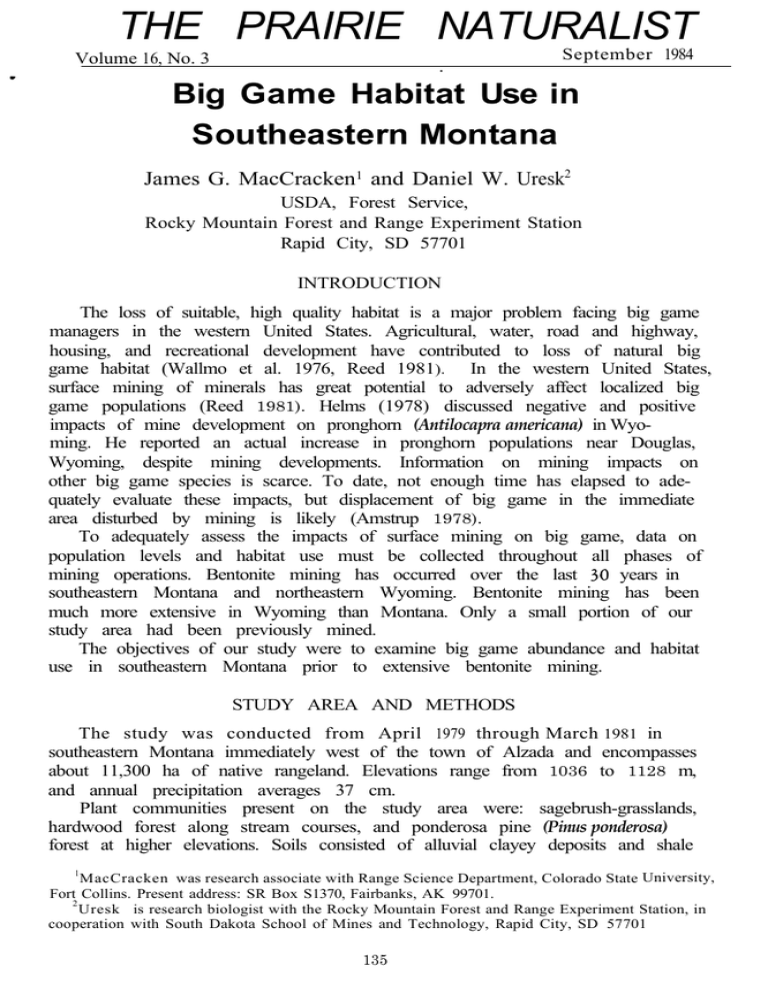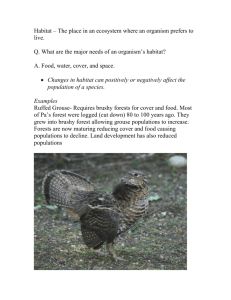THE PRAIRIE NATURALIST Big Game Habitat Use in
advertisement

THE PRAIRIE NATURALIST Volume 16, No. 3 . September 1984 Big Game Habitat Use in Southeastern Montana James G. MacCracken1 and Daniel W. Uresk2 USDA, Forest Service, Rocky Mountain Forest and Range Experiment Station Rapid City, SD 57701 INTRODUCTION The loss of suitable, high quality habitat is a major problem facing big game managers in the western United States. Agricultural, water, road and highway, housing, and recreational development have contributed to loss of natural big game habitat (Wallmo et al. 1976, Reed 1981). In the western United States, surface mining of minerals has great potential to adversely affect localized big game populations (Reed 1981). Helms (1978) discussed negative and positive impacts of mine development on pronghorn (Antilocapra americana) in Wyoming. He reported an actual increase in pronghorn populations near Douglas, Wyoming, despite mining developments. Information on mining impacts on other big game species is scarce. To date, not enough time has elapsed to adequately evaluate these impacts, but displacement of big game in the immediate area disturbed by mining is likely (Amstrup 1978). To adequately assess the impacts of surface mining on big game, data on population levels and habitat use must be collected throughout all phases of mining operations. Bentonite mining has occurred over the last 3 years in southeastern Montana and northeastern Wyoming. Bentonite mining has been much more extensive in Wyoming than Montana. Only a small portion of our study area had been previously mined. The objectives of our study were to examine big game abundance and habitat use in southeastern Montana prior to extensive bentonite mining. STUDY AREA AND METHODS The study was conducted from April 1979 through March 1981 in southeastern Montana immediately west of the town of Alzada and encompasses about 11,300 ha of native rangeland. Elevations range from 1036 to 1128 m, and annual precipitation averages 37 cm. Plant communities present on the study area were: sagebrush-grasslands, hardwood forest along stream courses, and ponderosa pine (Pinus ponderosa) forest at higher elevations. Soils consisted of alluvial clayey deposits and shale 1 MacCracken was research associate with Range Science Department, Colorado State University, Fort Collins. Present address: SR Box S1370, Fairbanks, AK 99701. 2 Uresk is research biologist with the Rocky Mountain Forest and Range Experiment Station, in cooperation with South Dakota School of Mines and Technology, Rapid City, SD 57701 135 at higher elevations. Surface deposits of bentonite clay were numerous. Aerial surveys, using a small fixed-wing aircraft, were made monthly to ascertain big game distribution and abundance. Flights were conducted on two consecutive mornings during the second week of each month. A total count of animals present was attempted by flying the entire area along north-south belt transects (Caughley 1977), 0.5 km wide, at about 6 0 m altitude. Observers included the pilot and two biologists. Big game observed were counted and identified by species, recorded as to which plant community they originally occupied, and locations plotted on a map. Big game population densities were calculated as the number of animals per 100 km2 of each plant community per day. A 3-way analysis of variance was used to test for differences in big game population density among plant communities, big game species, and seasons. Tukey’s method was used as a mean separation test to determine which factors accounted for differences (P<0.05) in big game densities. December through February comprised the winter season; March through May, spring; June through August, summer; and September through November, fall. Plant community characteristics were measured during summers 1979 and 1980. Four sample sites were examined in both the sagebrush-grass and hardwood forests, and two sample sites in the pine forest. Sample sites were chosen to be representative of a plant community. The number of replications of sample sites in each plant community were based on community variability and/or the land area occupied. At each sample site, canopy cover of plants was estimated along three 50-m line transects, 30.5m apart. Fifty quadrats (2 x 5 dm), spaced at 1-m intervals, were examined on each transect (Daubenmire 1959). The number of trees per hectare was estimated by counting all individuals in a 50 x 50-m plot at each sample site. Plant names follow Scott and Wasser (1980). RESULTS Vegetation mapping indicated that sagebrush-grass occupied 74% of the study area. The most abundant plants in that type were big sagebrush (Artemisia tridentata), common buffalograss (Buchloe dactyloides), blue grama (Bouteloua gracilis), plains pricklypear (Opuntia polyacantha), Hood phlox (Phlox hoodii), and common yarrow (Achillea millefolium). Hardwood forest occurred along stream bottoms and occupied about 14% of the study area. Major plants were boxelder maple (Acer negundo), green ash (Fraxinus pennsylvanicus), snowberry (Symphoricarpos sp. ), rose (Rosa spp. ), brome (Bromus spp. ), and bluegrass (Poa spp.). Pine forest grew on 8 % of the study area. It consisted of ponderosa pine, Rocky Mountain juniper (Juniperus scopulorum), bur oak (Quercus macrocarpa), western wheatgrass (Agropyron smithii), blue grama, common yarrow, and starry cerastium (Cerastium arvense). About 3 % of the study area had been mined for bentonite prior to the initiation of study. The sagebrush-grass community had the most bare ground. Litter cover was greatest in both forest types. Canopy cover of grasses and carices was greatest in sagebrush-grass and hardwood forest areas. Forb cover was nearly equal among all plant communities, while shrub cover was greatest in hardwood forest and 136 sagebrush-grass areas. Tree density was greatest in the hardwood forest community (Table 1). Big game observed were mule deer (Odocoileus hemionus), white-tailed deer (0. virginianus), and pronghorn. Mule deer were the most abundant (P<0.05) species on the study area, followed by pronghorn (Table 2). Both mule and whitetailed deer were observed more often in hardwood forest than any other plant community (P<0.05). However, mule deer occupation of pine forest was greatest in summer followed by spring, while white-tailed deer occupancy was greatest in fall followed by winter. Pronghorn were observed most often in sagebrushgrass areas but were occasionally seen in the other plant communities. Big game were observed in greater numbers in spring and summer than fall and winter. Differences between years in big game density appeared to be unimportant. Multiple classification analyses indicated that variation in big game population densities during winter and summer accounted for seasonal differences (P<0.05), hardwood forest areas accounted for differences (P<0.05) in big game densities among plant communities, and that variation in mule deer density accounted for differences (P<0.05) among species. DISCUSSION Both hardwood and pine forest communities were important to mule deer in southeastern Montana. However, hardwood forests supported more mule deer than pine forests. Severson and Carter 9 concluded that hardwood forest habitat was critical to mule deer survival on the northern High Plains. Mackie (1970) stated that pine/juniper woodlands of northern Montana were heavily used by mule deer in summer, and concluded that this was seasonally important habitat. Results of this study indicate that the same relationships exist in southeastern Montana. Severson (1981) discussed these relationships in detail. White-tailed deer were also most abundant in the hardwood forest community. Zwank et al. (1979) reported that bottomland hardwood forests were critical Table 1. Canopy cover (%) and tree densities in three plant communities, southeastern Montana, 1979-80. Categories Bare ground Litter Grasses and carices Forbs Shrubs Total Covera Trees / ha a Two Hardwood forest x & SE 8 + 1 30 +_ 3 39 +, 14 9+4 18 + 6 64 7 5 765 + 308 dimensional cover values. 137 Plant community Sagebrush-grass x + SE 21 + 1 20 ; 5 40 + 28 5I2 8 + 2 57 + 8 Pine forest % + SE 12 + 2 46 5 22 T 5 I 2 + 37 7 354 I 6 4 2 1 8 99 Table 2. Mean number of big game animals/ 100 km2 observed during aerial surveys in three plant communities over four seasons in southeastern Montana.a Season Big game plant species and community Winter Spring ~- Summer Fall Mule deer Hardwood forest Sagebrush-grass Pine forest 40f 8 31 90agh 6a 44mnu 155bij 1bc 56cop 78dekl 1d 10e 21 0 5 6g 0 0m 4i 0 0o 18k 0 13 White-tailed deer Hardwood forest Sagebrush-grass Pine forest Pronghorn Hardwood forest Sagebrush-grass Pine forest 0f 22 0 a Values followed by same letter differed columns. 6h 28 2n 1j 23 0p 1 0 20 0 (P< - 0.05) across rows and down habitat for this species in the midwest Use of forest communities by white-tailed deer in Oregon was also important (Suring and Vohs 1979). White-tailed deer use of ponderosa pine forest was restricted to fall and winter periods in this study. Sagebrush-grass areas provide critical habitat for pronghorn on the study area. Use of other plant communities by pronghorn was minimal. Aerial surveys were game during other parts in habitat use by mule during night in South conducted only in the morning and habitat use by big of the day may change. Steigers (1981) reported a shift deer fawns from woody draws by day to open prairie Dakota. Commercial grade bentonite occurs in scattered pockets, which has resulted in small, disturbed areas within undisturbed vegetation on the study area. Bentonite mining as currently practiced appears not to have had a serious impact on big game populations on the study area. However, lack of premining data precludes more definite statements. When demand for bentonite is high, it may become profitable to mine lower quality bentonite deposits, which will result in larger areas being disturbed, and thus, potentially cause greater impacts on big game populations. 138 ACKNOWLEDGMENTS We thank the Fosters of Wyotana Ranch, the Carlton Grazing Association, Lynn Alexander, and G. Brimmer for cooperation in this study. LITERATURE CITED Amstrup, S. C. 1978. Activities and habitat use pattern of pronghorns on Montana and Wyoming coal lands. Proc. Pronghorn Antelope Workshop 8:270-306 Caughley, G. 1977. Sampling in aerial survey. J. Wildl. Manage. 41:605-615. Daubenmire, R. 1959. A canopy-coverage method of vegetation analysis. Northwest Sci. 33:43-64. Helms, B. 1978. Antelope and energy development. Proc. Pronghorn Antelope Workshop 8:206-2 15. Mackie, R. J. 1970. Range ecology and relations of mule deer, elk, and cattle in the Missouri River Breaks, Montana. Wildl. Monogr. 20. Reed, D. F. 198 1. Conflicts with civilization Pp. 509-5 35 in Mule and blacktailed deer of North America (0. C. Wallmo, ed. ). University Nebraska Press, Lincoln. Scott, T. G., and C. H. Wasser. 1980. Checklist of North American plants for wildlife biologists. The Wildlife Society, Washington, D.C. Severson, K. E. 1981. Plains habitats. Pp. 459-485 in Mule and black-tailed deer of North America (0. C. Wallmo, Ed.). University. Nebraska Press, Lincoln. Severson, K. E., and A. V. Carter. 1978. Movements and habitat use by mule deer in the Northern Great Plains, South Dakota. Pp. 466-468 in Proc. First Int. Rangelands Congr. (D. W. Hyder, ed.). The Society for Range Management, Denver. Steigers, W. D., Jr. 1981. Habitat use and mortality of mule deer fawns in western South Dakota. Ph.D. Dissertation. Brigham Young University, Provo, Utah. Suring, L. H., and P. A. Vohs, Jr. 1979. Habitat use by Columbia white-tailed deer. J. Wildl. Manage. 43:610-619. Wallmo, 0. C., D. F. Reed, and L. H. Carpenter. 1976. Alteration of mule deer habitat by wildfire, logging, highways, agriculture, and housing developments. Pp. 37-47 in Mule deer decline in the west, a symposium (G. W. Workman and J. B. Low, eds.) Utah Agricultural Experiment Station, Logan. Zwank, P. J., R. D. Sparrowe, W. R. Porath, and 0. Torgeson. 1979. Utilization of threatened bottomland habitats by white-tailed deer. Wildl. Soc. Bull. 7:226-232. 139



